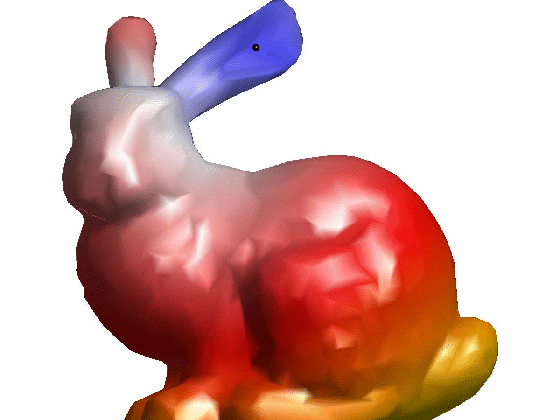- UID
- 188646
- 积分
- 646
- 精华
- 贡献
-
- 威望
-
- 活跃度
-
- D豆
-
- 在线时间
- 小时
- 注册时间
- 2004-10-31
- 最后登录
- 1970-1-1
|
马上注册,结交更多好友,享用更多功能,让你轻松玩转社区。
您需要 登录 才可以下载或查看,没有账号?立即注册


×
本帖最后由 LoveArx 于 2016-12-16 18:08 编辑
曲面上的测地线,也就是曲面上两点间的最短路径。
[url=http://www.docin.com/p-509878812.htmlhttp://www.docin.com/p-509878812.html]
http://www.cnblogs.com/shushen/p/5174421.html
网格测地线算法(Geodesics in Heat)附源码
测地线又称为大地线,可以定义为空间曲面上两点的局部最短路径。测地线具有广泛的应用,例如在工业上测地线最短的性质就意味着最优最省,在航海和航空中,轮船和飞机的运行路线就是测地线。[Crane et al. 2013]提出了利用热运动方程来计算网格测地线的方法,可以想象一下,当一根烫的针尖接触到曲面上的一点时,热量会随着时间的推移而扩散,测地距离因此可以和热运动相联系。具体算法过程如下图所示: 第一步:热运动方程用来描述热的传播状态: 将热运动方程离散化并整理后得到: 其中:id为单位矩阵,t为时间间隔,Δ为离散Laplacian算子,ut为t时刻的热状态,u0为初始时刻的热状态。 第二步:第一步计算得到的热梯度方向与测地距离的梯度方向相同,由Eikonal方程知道测地距离的梯度为单位向量,于是通过归一化热梯度我们得到测地距离的梯度: 第三步:得到测地距离的梯度之后,测地线问题即变为求解以下式子: 根据变分法,上式最小化即求解泊松方程: 其中:Φ即为网格上顶点距离源点的测地距离。
[url=]
 [/url]
[/url]
function [D] = geodesics_in_heat(V, F, src) % choose time step c = 5; t = c * mean(doublearea(V, F))/2; %% Step 1: Integrate the heat flow for some fixed time t L = cotmatrix(V, F); M = massmatrix(V, F, 'barycentric'); nV = size(V, 1); u0 = zeros(nV, 1); u0(src) = 1; A = M - t*L; B = M*u0; nsrc = length(src); % 1.1 dirichlet condition hole = Cal_Boundary(F); if isempty(hole) boundary = []; else boundary = hole.boundary.edge(:,1)'; end b = setdiff(boundary, src); nb = [b, src]; Acons = sparse([1:length(nb)], nb, ones(1,length(nb)), length(nb), nV); Bcons = [zeros(length(b), 1); ones(nsrc, 1)]; % 硬约束 r = setdiff([1:nV], nb); uD = [A(r,:);Acons]\[B(r,:);Bcons]; % 1.2 neumann condition Acons = sparse([1:nsrc], src, ones(1,nsrc), nsrc, nV); Bcons = ones(nsrc, 1); % 硬约束 r = setdiff([1:nV], src); uN = [A(r,:);Acons]\[B(r,:);Bcons]; % averaged boundary condition u = 0.5*(uN + uD); %% Step 2: Evaluate the vector field X G = grad(V, F); % nF*3 by nV matrix(梯度算子 - 所有三角片顶点基函数) grad_u = reshape(G*u, size(F,1), 3); % nF by nV matrix(所有三角片中u的梯度) grad_u_norm = sqrt(sum(grad_u.^2, 2)); normalized_grad_u = bsxfun(@rdivide, grad_u, grad_u_norm+eps); X = -normalized_grad_u; %% Step 3: Solve the Poisson equation Div = div(V, F); % 散度算子 div_X = Div*X(:); % #nV by #nF*3 Lcons = sparse([1:nsrc], src, ones(1,nsrc), nsrc, nV); div_Xcons = zeros(nsrc, 1); % 硬约束 r = setdiff([1:nV], src); D = [L(r,:);Lcons]\[div_X(r,:);div_Xcons]; D = D - min(D);end[url=]
 [/url]
[/url]
效果:


参考文献: [1] Keenan Crane, Clarisse Weischedel, and Max Wardetzky. 2013. Geodesics in heat: A new approach to computing distance based on heat flow. ACM Trans. Graph. 32, 5, Article 152 (October 2013), 11 pages.
|
|
 如果你在论坛求助问题,并且已经从坛友或者管理的回复中解决了问题,请把帖子标题加上【已解决】;
如果你在论坛求助问题,并且已经从坛友或者管理的回复中解决了问题,请把帖子标题加上【已解决】; 如何回报帮助你解决问题的坛友,一个好办法就是给对方加【D豆】,加分不会扣除自己的积分,做一个热心并受欢迎的人!
如何回报帮助你解决问题的坛友,一个好办法就是给对方加【D豆】,加分不会扣除自己的积分,做一个热心并受欢迎的人!
 |申请友链|Archiver|手机版|小黑屋|辽公网安备|晓东CAD家园
( 辽ICP备15016793号 )
|申请友链|Archiver|手机版|小黑屋|辽公网安备|晓东CAD家园
( 辽ICP备15016793号 )